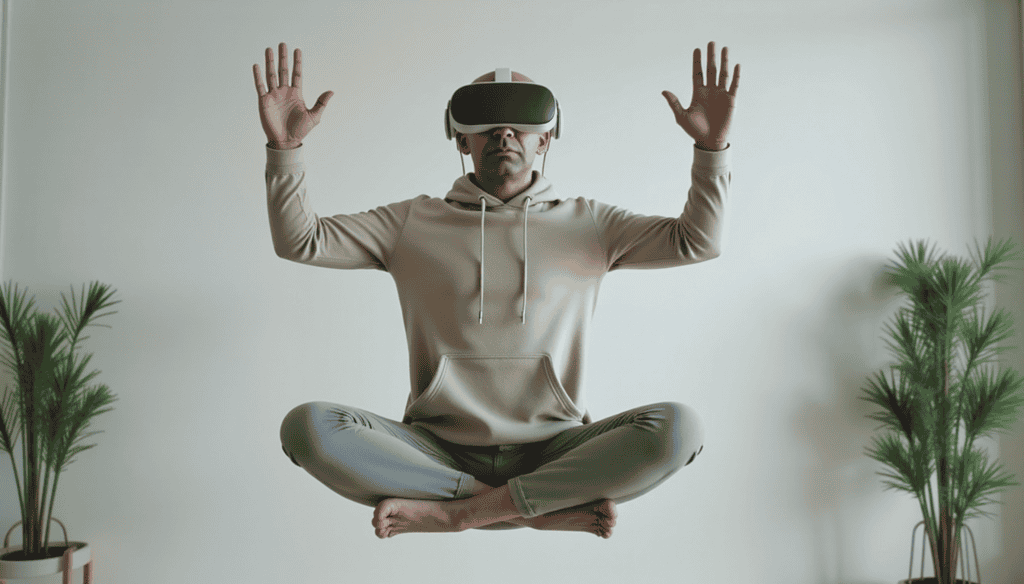

I've never had an easy relationship with sport. Not because I don't want to - on the contrary, I admire people who are regularly active and feel great afterwards. However, things are different for me: when I exercise intensively, my body usually goes on the counterattack about an hour later - severe migraines, aching limbs and circulatory problems set in. It feels as if my body is really rebelling. My doctors believe that an underlying metabolic disorder is a significant factor.
For this reason, many things were simply not feasible for me. Jogging, mountain biking, HIIT workouts - all these activities, which many consider to be the epitome of healthy exercise, often lead to complete failure for me the next day. I have tried several times to "get used to it", but the result has always been the same: painkillers, rest and a state in which migraine-like tension pains make thinking considerably more difficult. I would never allow myself to be in such a state again.
Before I turned to VR sports, I also tried out some approaches that turned out to be supposed "cheats" for lazy people, such as walking on the treadmill while working or EMS training. Although these methods certainly have their advantages and could be helpful for others, I personally lacked the motivation to integrate them into my everyday life on a permanent basis. Standing on the treadmill all the time gets on my nerves and I'm also too lazy to put on the EMS equipment consistently
The advantages of the VR-Sports go far beyond just training customization. One of the biggest advantages is the portability of the VR glasses: thanks to their compact design and ease of use, I can take my training station with me almost anywhere - whether in a hotel room when traveling, in my own living room or even in a quiet park. This keeps my routine flexible and I can Be active with VRwithout being tied to fixed locations or opening hours.
Another plus point is the variety of programs available. The VR sports apps offer an impressively varied selection of interactive workouts - from boxing and dance exercises to cardio and strength training to special stretching routines. This variety ensures that training never gets monotonous and gives me the opportunity to try out different exercises depending on my current condition and mood. This variety motivates me to stay active on a regular basis and allows me to discover new training methods that suit my needs.
The financial aspect should also not be neglected: The cost of VR sports is usually moderate compared to the often high membership fees of a gym. With a one-off investment in VR glasses and the associated apps, I can access a wide range of high-quality training content without constantly spending a fortune. That makes the VR sport an attractive alternative for anyone looking for inexpensive but effective training options.
Another personal advantage is the undisturbed atmosphere that VR sport offers me. In the virtual environment, I don't have to worry about how I look or whether I'm being awkward. This takes away the social pressure that often comes with traditional gyms and allows me to train with confidence and ease. This freedom to exercise without judgment or comparison to others boosts my self-confidence and promotes a positive attitude towards exercise.
Overall, VR-Sport offers a unique combination of flexibility, variety, cost efficiency and personal convenience - all of which it makes possible for me, to be active with VR and develop a training routine that is precisely tailored to my needs. The playful approach and the numerous interactive elements not only ensure fun and motivation, but also make the path to more exercise sustainably attractive and practicable.
Meta presents MHMS as Progress for companiesbut in reality it is a massive Increase in the cost of the entire Quest management. Companies that previously only paid for hardware and MDM must now pay an additional €179.99 per device per year to Meta.
🔹 Quest management costs have increased by up to 50-100 %.
🔹 Companies must Thousands of euros more for their VR fleet.
🔹 If these additional costs do not appear to be justified, the alternative headsets (Pico, HTC) worth considering.
For companies that have already invested in Meta Quest, this is a bitter pill to swallow. The most important question remains: Is the cost increase really worth it or are there better alternatives?
In addition to the programs mentioned above, I would also like to give a few tips on the VR sports apps that I personally like to use:
Rumble Boxing: Ideal if you want to work off your energy in a targeted way. The structured boxing routines help me to stay active even on stressful days.
Stretch Labs: Perfect for relieving tension and gently stretching the body after long hours in front of the screen.
FitXR: This app offers an impressive variety of workouts - whether cardio, dance or strength training, it remains varied and motivating.
Les Mills BodyCombat: For those who appreciate the rhythm and energy of group training, this program is an intensive and motivating option.
I am not claiming that VR sport is the perfect solution for everyone. But for someone who regularly struggles with traditional sports - be it for health, mental or social reasons - it offers a real advantage. It may not seem spectacular, but it's real and helpful: a way to get moving again without my body demanding the price afterwards. VR not only allows me to train flexibly, but also to be active with VRwhich enriches my everyday life in the long term.

Are you interested in developing a virtual reality or 360° application? You may still have questions about budget and implementation. Feel free to contact me.
I am looking forward to you
Clarence Dadson CEO Design4real